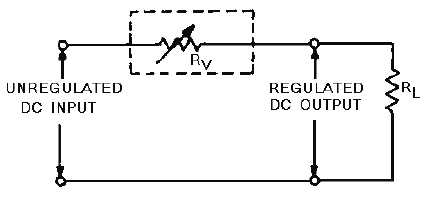4-38
The schematic drawing in view A is that of a shunt-type regulator. It is called a shunt-type regulator
because the regulating device is connected in parallel with the load resistance. The schematic drawing in
view B is that of a series regulator. It is called a series regulator because the regulating device is
connected in series with the load resistance. Figure 4-32 illustrates the principle of series voltage
regulation. As you study the figure, notice that the regulator is in series with the load resistance (RL) and
that the fixed resistor (RS) is in series with the load resistance.
Figure 4-32.—Series voltage regulator.
You already know the voltage drop across a fixed resistor remains constant unless the current
flowing through it varies (increases or decreases). In a shunt regulator, as shown in figure 4-33, output
voltage regulation is determined by the current through the parallel resistance of the regulating device
(RV), the load resistance (RL), and the series resistor (RS). For now, assume that the circuit is operating
under normal conditions, that the input is 120 volts dc, and that the desired regulated output is 100 volts
dc. For a 100-volt output to be maintained, 20 volts must be dropped across the series resistor (RS). If you
assume that the value of RS is 2 ohms, you must have 10 amperes of current through RV and R
L.
(Remember: E = IR.) If the values of the resistance of R
V
and RL are equal, 5 amperes of current will
flow through each resistance (RV and RL).
Figure 4-33.—Shunt voltage regulator.
Now, if the load resistance (RL) increases, the current through RL will decrease. For example, assume
that the current through RL is now 4 amperes and that the total current through RS is 9 amperes. With this



